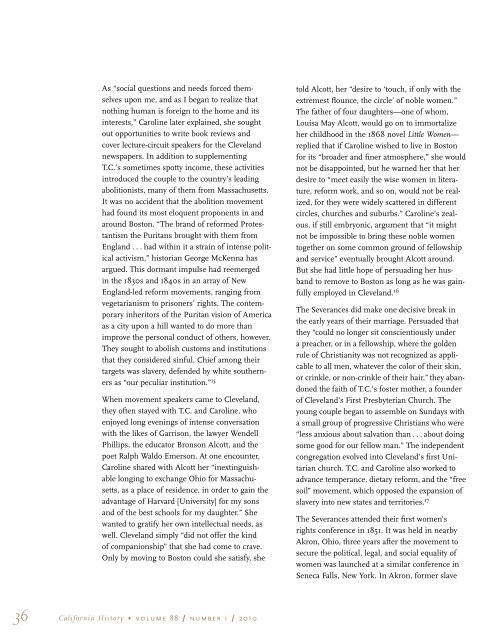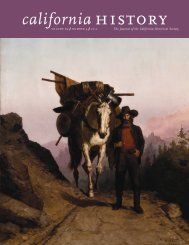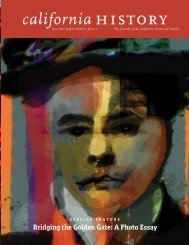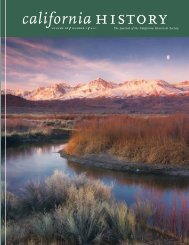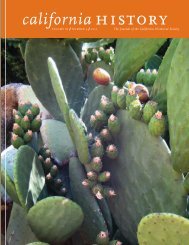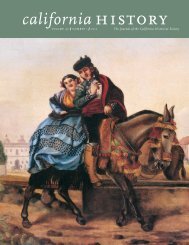As “social questions and needs forced themselvesupon me, and as I began to realize thatnothing human is foreign to the home and itsinterests,” Caroline later explained, she soughtout opportunities to write book reviews andcover lecture-circuit speakers for the Clevelandnewspapers. In addition to supplementingT.C.’s sometimes spotty income, these activitiesintroduced the couple to the country’s leadingabolitionists, many of them from Massachusetts.It was no accident that the abolition movementhad found its most eloquent proponents in andaround Boston. “The brand of reformed Protestantismthe Puritans brought with them fromEngland . . . had within it a strain of intense politicalactivism,” historian George McKenna hasargued. This dormant impulse had reemergedin the 1830s and 1840s in an array of NewEngland-led reform movements, ranging fromvegetarianism to prisoners’ rights. The contemporaryinheritors of the Puritan vision of Americaas a city upon a hill wanted to do more thanimprove the personal conduct of others, however.They sought to abolish customs and institutionsthat they considered sinful. Chief among theirtargets was slavery, defended by white southernersas “our peculiar institution.” 15When movement speakers came to Cleveland,they often stayed with T.C. and Caroline, whoenjoyed long evenings of intense conversationwith the likes of Garrison, the lawyer WendellPhillips, the educator Bronson Alcott, and thepoet Ralph Waldo Emerson. At one encounter,Caroline shared with Alcott her “inextinguishablelonging to exchange Ohio for Massachusetts,as a place of residence, in order to gain theadvantage of Harvard [University] for my sonsand of the best schools for my daughter.” Shewanted to gratify her own intellectual needs, aswell. Cleveland simply “did not offer the kindof companionship” that she had come to crave.Only by moving to Boston could she satisfy, shetold Alcott, her “desire to ‘touch, if only with theextremest flounce, the circle’ of noble women.”The father of four daughters—one of whom,Louisa May Alcott, would go on to immortalizeher childhood in the 1868 novel Little Women—replied that if Caroline wished to live in Bostonfor its “broader and finer atmosphere,” she wouldnot be disappointed, but he warned her that herdesire to “meet easily the wise women in literature,reform work, and so on, would not be realized,for they were widely scattered in differentcircles, churches and suburbs.” Caroline’s zealous,if still embryonic, argument that “it mightnot be impossible to bring these noble womentogether on some common ground of fellowshipand service” eventually brought Alcott around.But she had little hope of persuading her husbandto remove to Boston as long as he was gainfullyemployed in Cleveland. 16The Severances did make one decisive break inthe early years of their marriage. Persuaded thatthey “could no longer sit conscientiously undera preacher, or in a fellowship, where the goldenrule of Christianity was not recognized as applicableto all men, whatever the color of their skin,or crinkle, or non-crinkle of their hair,” they abandonedthe faith of T.C.’s foster mother, a founderof Cleveland’s First Presbyterian Church. Theyoung couple began to assemble on Sundays witha small group of progressive Christians who were“less anxious about salvation than . . . about doingsome good for our fellow man.” The independentcongregation evolved into Cleveland’s first Unitarianchurch. T.C. and Caroline also worked toadvance temperance, dietary reform, and the “freesoil” movement, which opposed the expansion ofslavery into new states and territories. 17The Severances attended their first women’srights conference in 1851. It was held in nearbyAkron, Ohio, three years after the movement tosecure the political, legal, and social equality ofwomen was launched at a similar conference inSeneca Falls, New York. In Akron, former slave<strong>California</strong> History • volume 88 number 1 2010
Sojourner Truth gave what famously becameknown as her “Ain’t I a Woman?” speech.Sojourner’s passionate call to right the injusticesvisited upon the supposed weaker sex in thename of protecting it (“Look at me! Look at myarm! I have ploughed and planted, and gatheredinto barns, and no man could head me! Andain’t I a woman?”) must have stirred Caroline’ssoul. She subsequently attended women’s rightsconferences in Ohio, Indiana, and New York,where she listened to speeches, helped to passresolutions, and deliberated on strategies for winningthe support of the press, the pulpit, and thepolitical establishment for women’s suffrage andequal property rights. 18As the majority of Cleveland’s women ofmeans—the “primitive 400,” Caroline later calledthem—remained preoccupied with less weightymatters, Caroline gained recognition as the city’spreeminent women’s rights proponent. Mrs. Severancemay have lacked the stereotypical femininecharms (biographers describe her as “severeof countenance, caring nothing for fashion, neitherwitty, brilliant, nor very rich”), but she was anatural leader. 19In 1853, Cleveland’s Mercantile Library Association,a forum for the most prominent publicspeakers of the day, invited Caroline to delivera lecture on women’s rights. The organizationhad never before offered its podium to a female.Possessed of a lifelong fear of public speakingshe attributed to a childhood anxiety that anutterance could doom her to eternal punishment,Caroline initially pleaded her unfitness forthe assignment, but her sense of duty won outand she set about to write the “most exhaustiveessay I could . . . , to make sure, for once, thatmy city should have all that could be said on thesubject.” Her talk, “Humanity, A Definition witha Plea,” caused a “great sensation,” igniting passionsboth pro and con. Its central thesis, shelater explained, was that the state had a duty to“take the mother from the category of the alien,the criminal, and the lunatic, and place her . . . asan equal partner” of her husband and of her son,“the two who sit beside her hearth.” 20Caroline’s supporters in the audience presentedher with a handsome bound set of the completeworks of William Shakespeare as a mementoof her accomplishment, and she quickly foundherself in great demand as a lecturer. She presentedversions of “Humanity” before generalaudiences, women’s rights conferences, and eventhe Ohio Senate. Both she and T.C. were electedofficers of the fourth national women’s rightsconvention, held in Cleveland’s Melodeon Hallin 1854. There they and fifteen hundred otherattendees debated with movement leaders LucretiaMott and former Oberlin College studentsLucy Stone and Antoinette Brown Blackwell (thefirst American woman to be ordained a minister)the merits of such radical reforms as the rightof women to divorce alcoholic husbands andthe right of women to receive tax exemptionsuntil such time as their gender was awardedsuffrage. Cleveland—and the nation—remainedunmoved. 21Caroline later identified the event that finallysealed her decision to leave Ohio: the gatheringof Clevelanders in the city’s parks and publicspaces to await the second coming of Christ,which had been predicted by New York Statefarmer and self-appointed biblical scholar WilliamMiller. Or at least this was the reason shegave for uprooting the family to Boston, accordingto her son Mark Sibley Severance, whohimself never forgot the sight of a family of Millerites,sitting astride or holding on to the tail oftheir old white plow horse, ready for their ascentto heaven. Fearing that “this Millerite movementmight be demoralizing and at any rate fearingthe influence of the City of Cleveland on heryoung children . . . ,” Mark explained in his autobiography,“Mother and Father decided to take usall to Boston to be educated.” 227
- Page 3: california historyvolume 88 number
- Page 6 and 7: c o l l e c t i o n sAdmission tick
- Page 8 and 9: c o l l e c t i o n sBusiness cards
- Page 10 and 11: People’s Park:Birth and SurvivalB
- Page 12 and 13: even on existing dorms due to the h
- Page 14 and 15: The attraction, however, was fleeti
- Page 16 and 17: Bay Area—North Beach and Haight-A
- Page 18 and 19: A hundred students, activists, and
- Page 20 and 21: are building a park on the land. We
- Page 22 and 23: and illegal drug use in the park. T
- Page 24: without even allowing Siegel to con
- Page 27 and 28: As Bloody Thursday came to a close,
- Page 29 and 30: this state.” On June 20, Reagan t
- Page 31 and 32: Denovo, her autopsy revealed a down
- Page 33 and 34: ation and encouragement, and shed n
- Page 35 and 36: the guardians of her children. The
- Page 37: mitted to visit Caroline in her new
- Page 41 and 42: After emancipation, she helped to o
- Page 43 and 44: This 1885 view captures the sparsel
- Page 45 and 46: But Caroline thought it imprudent t
- Page 47 and 48: The “Mother of Clubs”In Boston,
- Page 49 and 50: Caroline attended the September 189
- Page 51 and 52: ments, Seymour and Sibley earned pe
- Page 53 and 54: In this photograph, San Francisco s
- Page 55 and 56: n o t e s12People’s Park: Birth a
- Page 57 and 58: 1969; McGill, The Year of the Monke
- Page 59 and 60: that “thousands of the brightest
- Page 61 and 62: For Both Cross andFlag: Catholic Ac
- Page 63 and 64: d o n o r sThe California Historica
- Page 65 and 66: In Kind DonationsSandy Alderson, Sa
- Page 67: Membership BenefitsJoin tHeCaliforn


